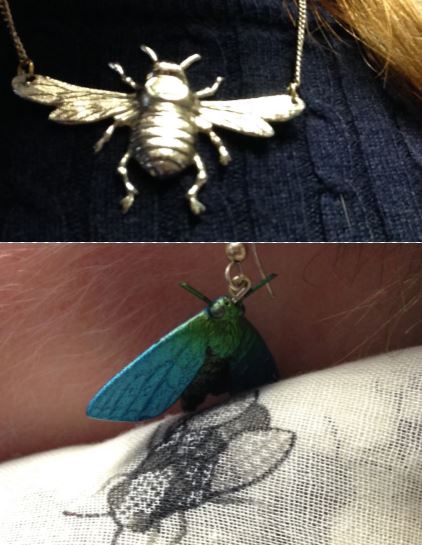Ento Day 2016 reviewed
Well it's 24 hours since Shropshire Ento Day 2016 began, and I'm still buzzing (pardon the pun)!
 Since moving to Shropshire and starting work with the Tom.bio project I've been amazed by the breadth and quality of the many entomological activities going on around the county. The Ento Day programme was a great showcase for this, with talks on a wide range of invertebrates from speakers both professionally employed as entomologists and those who do it essentially as a hobby at their own time and expense. This last group are traditionally referred to as 'amateurs', but I feel that this title never really reflect the dedication, passion, field craft and taxonomic skill on display.
Since moving to Shropshire and starting work with the Tom.bio project I've been amazed by the breadth and quality of the many entomological activities going on around the county. The Ento Day programme was a great showcase for this, with talks on a wide range of invertebrates from speakers both professionally employed as entomologists and those who do it essentially as a hobby at their own time and expense. This last group are traditionally referred to as 'amateurs', but I feel that this title never really reflect the dedication, passion, field craft and taxonomic skill on display.

First up was Ian Cheeseborough ('Cheese'), Shropshire's hymenoptera recorder, who gave a fascinating talk on parasitic spider-hunting wasps. These tiny creatures have rather gruesome life histories, paralysing their spider prey before entombing them alive in cells where the wasp lays its eggs - the spider, being paralysed rather than dead, will provide a store of fresh meat ready for the voracious appetite of the newly hatched wasp larvae...the talk was illustrated by some incredible photographs (e.g. right), showing wasps dragging and carrying spiders many times their size. The relative strength of these tiny insects must be enormous.
The next talk came from Pete Boardman, a familiar face to many in attendance and in many ways the driving force behind much of the entomology currently being done in the county. Pete has played a key role in various previous FSC Biodiversity projects, most recently Invertebrate Challenge, the project responsible for, among other things, creating many new county invertebrate recorders. Earlier this year Pete took up a post as an entomologist with Natural England's Field Unit, and his talk was a summary of the interesting year he's had surveying many protected sites around the country. These surveys have turned up several real rarities.
 Caroline Uff then gave a fascinating presentation on the real superstars of the beetle word - longhorns. These large and often colourful beetles are real showstoppers, and could be a real 'gateway group' into coleopteran ID. Apparently log stores are a great place to find them - so if you have a log burner or fire, check your log store! Many can be identified by photographs, and the national recording scheme is being reinvigorated by new students Will and Katy, who are expanding the social media presence of the group. Find them on Facebook! There is also a newly created Shropshire Longhorn Atlas, hosted here on the Tom.bio site.
Caroline Uff then gave a fascinating presentation on the real superstars of the beetle word - longhorns. These large and often colourful beetles are real showstoppers, and could be a real 'gateway group' into coleopteran ID. Apparently log stores are a great place to find them - so if you have a log burner or fire, check your log store! Many can be identified by photographs, and the national recording scheme is being reinvigorated by new students Will and Katy, who are expanding the social media presence of the group. Find them on Facebook! There is also a newly created Shropshire Longhorn Atlas, hosted here on the Tom.bio site.
The FSC's own Robin Sutton followed, in a joint presentation with moth recorder David Poynton. They showed (via some very funky graphs!) the results of some analyses they have recently done on a large database of moth trap records, dating back 25 years or more. These data, from two sites in Shropshire and also FSC Malham Tarn in Yorkshire, reveals some fascinating changes in the phenology of some commonly encountered moth species. There is real evidence that species which previously only had one generation per year are changing to become bivoltine (two generational). The assumption is that this is due to our changing climate. Their presentation really drove home the value of long term datasets - even if you don't know how your data may be used in the future, you should definitely keep it and submit it - who knows what patterns it may help reveal in the future!
After a coffee break, it was a Tom.bio heavy session - I spoke briefly about an idea we've had to run some 'wider skills' training for biological recorders covering topics such as pinning, curating, microscopy and preserving specimens. Then Rich gave an update on the excting Shropshire Springtail Atlas project - and our ambition to increase the geographic and taxonomic range of the Atlas.
 The first talk after lunch came from 'fly Nigel' (Jones), who gave us some highlights from his year of collecting at Haughmond Hill - the 'site that keeps on giving'! The number of national rarities Nigel has identified from this site is really astounding. Although undoubtedly a great site, it also demonstrates the value of looking - it seems unlikely that isolated populations of such species exist at Haughmond and nowhere else in the Midlands! Some of the highlights from this year included the discover of a well established population of the extremely rare robber fly Neomochtherus pallipes. See Nigel's Flickr site for some stunning images of this species.
The first talk after lunch came from 'fly Nigel' (Jones), who gave us some highlights from his year of collecting at Haughmond Hill - the 'site that keeps on giving'! The number of national rarities Nigel has identified from this site is really astounding. Although undoubtedly a great site, it also demonstrates the value of looking - it seems unlikely that isolated populations of such species exist at Haughmond and nowhere else in the Midlands! Some of the highlights from this year included the discover of a well established population of the extremely rare robber fly Neomochtherus pallipes. See Nigel's Flickr site for some stunning images of this species.
 It was the the turn of 'spider Nigel' (Cane-Honeysett), who gave a very entertaining account of the 'action spidering' (see right!) activities of the Shropshire Spider Group! Who'd have thought that spider-hunting was such dangerous/intrepid/exciting business! Tom.bio works very closely with the Shropshire Spider Group, and has developed a pathway of spider ID courses ranging from a 'Learn to Love Spiders' course to more advanced microscopy courses. Nigel also gave a big shout-out to those often neglected arachnids - harvestmen and pseudoscorpions. Keep a watch on our training page for details of various arachnid-themed courses in 2017...
It was the the turn of 'spider Nigel' (Cane-Honeysett), who gave a very entertaining account of the 'action spidering' (see right!) activities of the Shropshire Spider Group! Who'd have thought that spider-hunting was such dangerous/intrepid/exciting business! Tom.bio works very closely with the Shropshire Spider Group, and has developed a pathway of spider ID courses ranging from a 'Learn to Love Spiders' course to more advanced microscopy courses. Nigel also gave a big shout-out to those often neglected arachnids - harvestmen and pseudoscorpions. Keep a watch on our training page for details of various arachnid-themed courses in 2017...
It was back to FSC after this, with Keiron Brown giving an update on the BioLinks project bid. This will hopefully be the next FSC biodiversity project, continuing the legacy of Tom.bio when our project comes to an end in Jan 2018.
A pair of talk from Harper Adams academics rounded off the day. Andrew Cherill told us about the work he and his students have been doing, comparing the efficacy of various vacuum samplers. The conclusion - vacuum sampling is much more effective than sweep netting, and the best one to go for is the standard G-vac or garden vac - compares very favourable in price and efficacy to more expensive specialist models!
Francisca Sconce gave the final talk of the day, on the inaugural Harper Adams EntoSci16 event, a day aimed at secondary school students and designed to open their eyes to the careers available in entomology. FSC were present at this event, and can agree with Francisca's conclusions that it was a very good event, well received by students and teachers. Some of the most popular parts of the day were the 'star guests', TV naturalist George McGavin and NHM 'fly girl' Erica McAlister. The session on entophagy, or eating insects, was also very popular! This event will run again in 2018.
It was a fantastic event, and great to see so many people (nearly 100) there. There was a good turnout from Harper Adams students too, representing the next generation of entomologists and contradicting the oft-cited opinion that biological recording, especially of invertebrates, is dominated by the older generations...
 FSC Publications had a wide range of keys, fold-out charts and field guides on display, including several new titles, which as usual proved popular. Another popular feature of the day was the generous amount of time given to 'networking', catching up with old friends and making new ones. I also enjoyed seeing the wide range of invertebrate-themed accessories modeled by the attendees - jumpers, scarves, necklaces and earrings all on display. There were also rumours of some entomological-themed pants...thankfully not on display!
FSC Publications had a wide range of keys, fold-out charts and field guides on display, including several new titles, which as usual proved popular. Another popular feature of the day was the generous amount of time given to 'networking', catching up with old friends and making new ones. I also enjoyed seeing the wide range of invertebrate-themed accessories modeled by the attendees - jumpers, scarves, necklaces and earrings all on display. There were also rumours of some entomological-themed pants...thankfully not on display!
Thanks again to Preston Montford for hosting the event and feeding everyone so well! Bring on next year!
See tweets from the event via the hashtag #EntoDay16
- Anonymous's blog
- Log in or register to post comments



